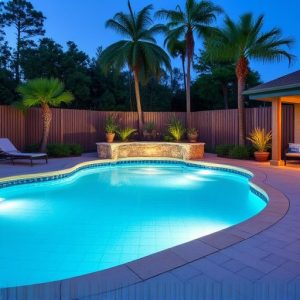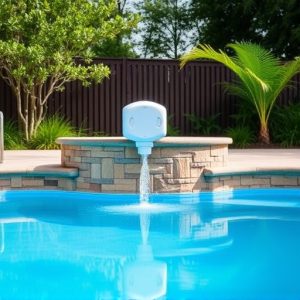Swim Safe: Maximizing Pool Alarm Security for Inground Pools
Swimming pool alarms for inground pools are a critical safety feature that detect unauthorized or a…….
Swimming pool alarms for inground pools are a critical safety feature that detect unauthorized or accidental entries into the water, triggering an alarm to prevent drowning, especially when there's no direct supervision. These alarms complement physical barriers like fencing and provide additional protection for homes with young children or pets. When selecting a swimming pool alarm, it's important to choose one compatible with your inground pool type and adjustable for sensitivity to minimize false alarms. Part of a comprehensive safety approach that includes adherence to local pool safety regulations, regular maintenance, and education on water safety, these systems are designed to enhance the overall safety of inground pool environments. Homeowners should consider various alarm types, such as perimeter or motion-detecting models, and ensure they are well-maintained for optimal performance. A holistic approach to inground pool safety involves not just installing an alarm but also implementing physical barriers, clear markers, signage, CPR training, emergency response drills, readily available rescue equipment, safe chemical balance, and meticulous maintenance of the entire pool system. This proactive strategy ensures that inground pools remain safe for all users.
Swimming pools offer a delightful escape from the heat and a venue for recreation, yet they come with inherent safety risks. To ensure the well-being of all who dive into the cool depths of an inground pool, understanding and implementing swimming pool alarms is not just prudent—it’s a critical measure for safety. This article delves into the essential aspects of selecting, installing, and maintaining the right swimming pool alarm system tailored for inground pools, as well as outlining best practices that go beyond these audible sentinels to keep your pool environment secure. With a focus on safeguarding lives, we explore how to harness technology to enhance your pool’s safety.
Understanding the Importance of Swimming Pool Alarms for Inground Pools
Swimming pool alarms for inground pools play a critical role in enhancing safety measures and are an indispensable component for any residential or public pool. These systems are designed to detect unauthorized or accidental access to the pool, providing an audible alert that can deter potential drowning incidents, especially when supervision is lacking. Inground pool alarms offer a layer of protection that complements other safety practices such as barriers and fencing by offering immediate notification to caretakers. They are particularly useful for homes with children or pets, where the risk of an unnoticed fall into the pool is heightened.
When selecting a swimming pool alarm for an inground pool, it’s important to consider the specific model’s compatibility with your pool setup and its sensitivity settings to minimize false alarms. Additionally, these alarms should be part of a comprehensive safety strategy that includes regular maintenance checks and adherence to local regulations regarding pool safety. By investing in a reliable swimming pool alarm system, pool owners can significantly reduce the risk associated with unintended water immersion events, fostering a safer environment for all users.
Types of Swimming Pool Alarms: Finding the Right Fit for Your Inground Pool
When prioritizing safety measures for an inground pool, investing in reliable swimming pool alarms is paramount. These devices serve as a vital line of defense to prevent unauthorized access and drowning incidents. There are several types of swimming pool alarms designed specifically for inground pools, each with unique features catering to diverse needs and settings. Perimeter alarm systems monitor the pool’s edges, sounding an alert when any disturbance is detected on the surface, effectively deterring unpermitted entry. Motion-detecting alarms are another option, designed to sense unusual water movements, ensuring immediate notification if a child or pet falls into the pool unattended. For homeowners with older children or guests, a secondary audible alarm system can be installed on the pool itself, emitting a loud noise when triggered.
Choosing the right swimming pool alarms for inground pools involves considering factors such as the size and shape of your pool, as well as the layout of your property. Wireless models offer flexibility in installation without compromising security or coverage. Additionally, tamper-resistant designs prevent unauthorized disabling, adding an extra layer of protection. When selecting a system, it’s important to assess the sensitivity settings and range of detection to ensure optimal performance. Moreover, consider alarms with remote monitoring capabilities, allowing you to receive notifications on your smartphone. By carefully evaluating these aspects, homeowners can select a swimming pool alarm system that offers peace of mind and aligns seamlessly with their inground pool’s unique requirements.
Installing and Maintaining Your Swimming Pool Alarm System
When securing your inground pool, investing in a reliable swimming pool alarm system is paramount to ensure the safety of all swimmers. These alarms are designed to detect unauthorized access or potential drowning hazards by sounding an immediate alert upon identifying movements in or around the water. Installing swimming pool alarms for inground pools involves careful selection based on your specific pool design and layout, as well as compliance with local regulations and safety standards. Once installed, regular maintenance checks are crucial to ensure the alarm system operates effectively. These checks should be conducted periodically to verify that the sensor’s sensitivity is calibrated correctly and that the sound output is audible across the entire pool area. Additionally, batteries, if applicable, should be tested and replaced as necessary to prevent false alarms or missed warnings due to power interruptions. By maintaining your inground pool alarm system diligently, you can significantly enhance the safety measures of your swimming environment, providing peace of mind for homeowners and frequent swimmers alike. It’s also advisable to familiarize yourself with the different types of alarms available, such as wave motion detectors or underwater motion sensors, to choose the most suitable option for your pool’s specific environment and usage patterns. Regular upkeep ensures that these critical safety systems function optimally, safeguarding against tragic accidents and contributing to a safer swimming experience.
Pool Safety Best Practices Beyond Alarms for Inground Pools
Ensuring the safety of inground pools extends beyond the mere installation of swimming pool alarms. A comprehensive approach to pool safety involves a multifaceted strategy that encompasses physical barriers, such as fencing with a self-closing and self-latching gate that is inaccessible to children, to prevent unauthorized access. The depth of the water should be clearly marked, and signage indicating the absence of a lifeguard should be visible to all users. Moreover, pool owners should maintain clear and unobstructed views of the pool area from the house, removing any obstructions that might offer hiding places for swimmers in distress.
Education is another critical component of pool safety. All individuals using the pool, especially those with young children or non-swimmers, should be trained in CPR and water rescue techniques. Regularly scheduled safety drills can familiarize users with emergency procedures. Additionally, pool owners must ensure that rescue equipment, such as life rings and a first aid kit, are readily available and that the pool’s chemical levels are properly balanced to avoid health hazards. Regular maintenance and inspection of the pool’s filtration, circulation, and cleaning systems are essential to maintain a safe swimming environment. By implementing these best practices, pool owners can create a safer atmosphere for swimmers of all ages to enjoy their time in and around inground pools.


